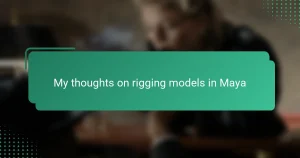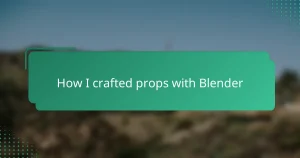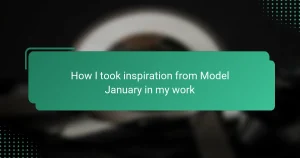Key takeaways
- Science fiction props should blend functionality and creativity, conveying a story through design.
- Choosing models for presentation involves curating pieces that resonate emotionally and showcase technical skill.
- Optimizing renders and project descriptions enhances viewer engagement and conveys the prop’s narrative effectively.
- Consistency in sharing work and engaging with the community on platforms like ArtStation fosters growth and recognition.
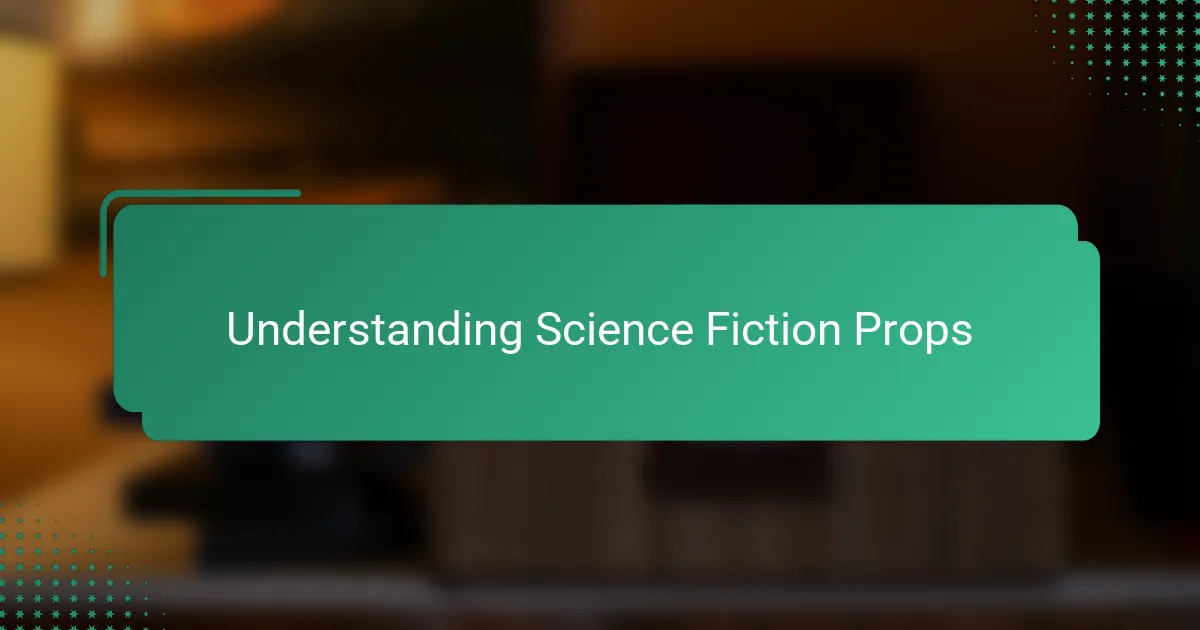
Understanding science fiction props
Science fiction props are more than just futuristic gadgets; they’re windows into imagined worlds. When I first started designing these props, I realized they needed to tell a story on their own—every button, scratch, and glowing panel had to hint at a larger narrative. Have you ever wondered what makes a prop feel truly believable, even if it’s completely out of this world?
In my experience, understanding the balance between functionality and creativity is key. A prop has to look like it serves a purpose, whether it’s a weapon, a tool, or a piece of technology. That practicality rooted in believable design strokes the viewer’s imagination, making the entire scene feel authentic.
What fascinates me most is how science fiction props reflect our hopes and fears about the future. Sometimes, while crafting these models, I catch myself thinking about real-world technology and where it might lead. It’s this connection between the fictional and the possible that creates such a compelling impact in my work.

Choosing the right models for showcase
Choosing the right models to showcase on ArtStation felt like curating a mini gallery of my favorite stories. I always ask myself, which pieces best represent my vision and technical skill? It’s not just about picking the flashiest models but those that genuinely resonate with the science fiction themes I’m passionate about.
Sometimes, I found myself hesitating between several models, each unique but telling a different story. What helped me decide was thinking about the emotional response I wanted to evoke—does this model spark curiosity or wonder? That personal connection often guided me towards the pieces that truly stood out.
In my journey, I realized that variety also plays a crucial role. Displaying a range of props, from weapons to gadgets, keeps the portfolio dynamic and engaging. It shows not only my versatility but also the depth of the worlds I create, inviting viewers to explore multiple facets of my imagination.
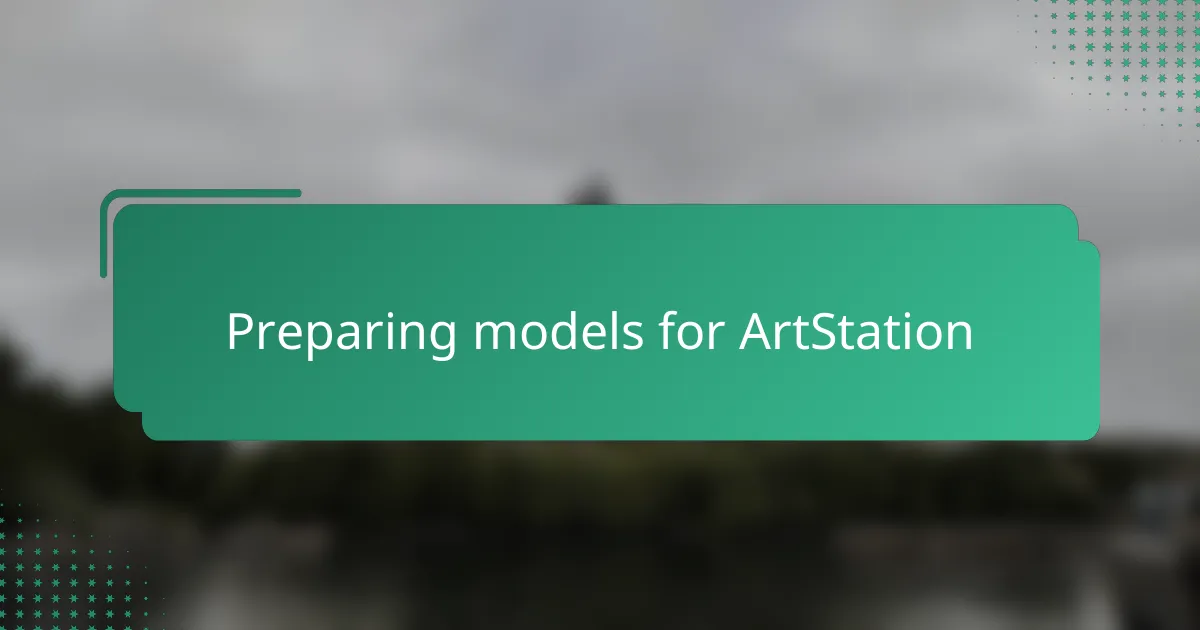
Preparing models for ArtStation
Preparing models for ArtStation meant more than just uploading files—it was about presenting my work in the best possible light. I always start by refining the geometry, ensuring the details are crisp but the model remains optimized; too many unnecessary polygons can bog down viewers or cause loading issues. Have you ever spent hours tweaking a small edge loop, only to realize that tiny change makes your model pop on-screen? That attention to detail is what I believe separates good models from great showcases.
Next came the texturing phase, which felt like giving life to cold geometry. I like to use PBR (Physically Based Rendering) materials because they react realistically to light, enhancing the sci-fi feel with subtle reflections and surface wear. To me, the scratches and grime aren’t imperfections—they’re storytelling elements, whispering hints about the prop’s history and use. Setting up the right lighting and environment in ArtStation’s viewer helped me frame each model so its personality truly shines.
Finally, preparing presentation shots forced me to think like a curator. I experimented with multiple camera angles, highlighting features I was most proud of. Sometimes I’d ask myself, which angle would catch a fellow artist’s eye or spark a viewer’s imagination? It became a learning process about visual storytelling that I found just as rewarding as modeling itself.
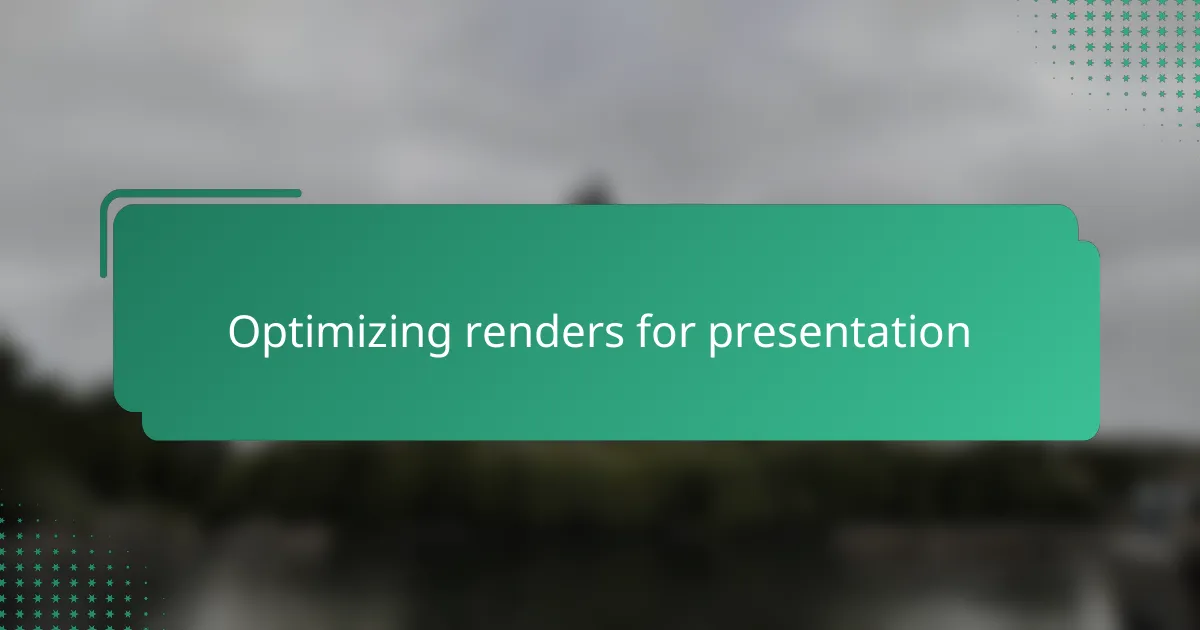
Optimizing renders for presentation
When I optimize renders for presentation, I always start by dialing in the lighting to emphasize the silhouette and textures of the prop. It’s surprising how a subtle shift in light angle can transform flat surfaces into something almost tactile, revealing the layers of detail I spent hours crafting. Have you noticed how even the smallest highlight can draw the viewer’s eye exactly where you want it?
Another trick I lean on is balancing render quality with practicality. I’ve learned that pushing for ultra-high resolution can sometimes backfire if it slows down loading or overwhelms the viewer. Finding that sweet spot where the render looks polished but stays efficient makes the difference between a scroll-past and a lingering gaze.
Post-processing is where the magic often happens for me. A gentle color tweak or a slight increase in contrast can elevate the mood, making the prop feel part of a lived-in science fiction universe. I ask myself: does this render evoke the atmosphere I imagined when designing it? If the answer is yes, then I know I’ve hit the right tone for presentation.
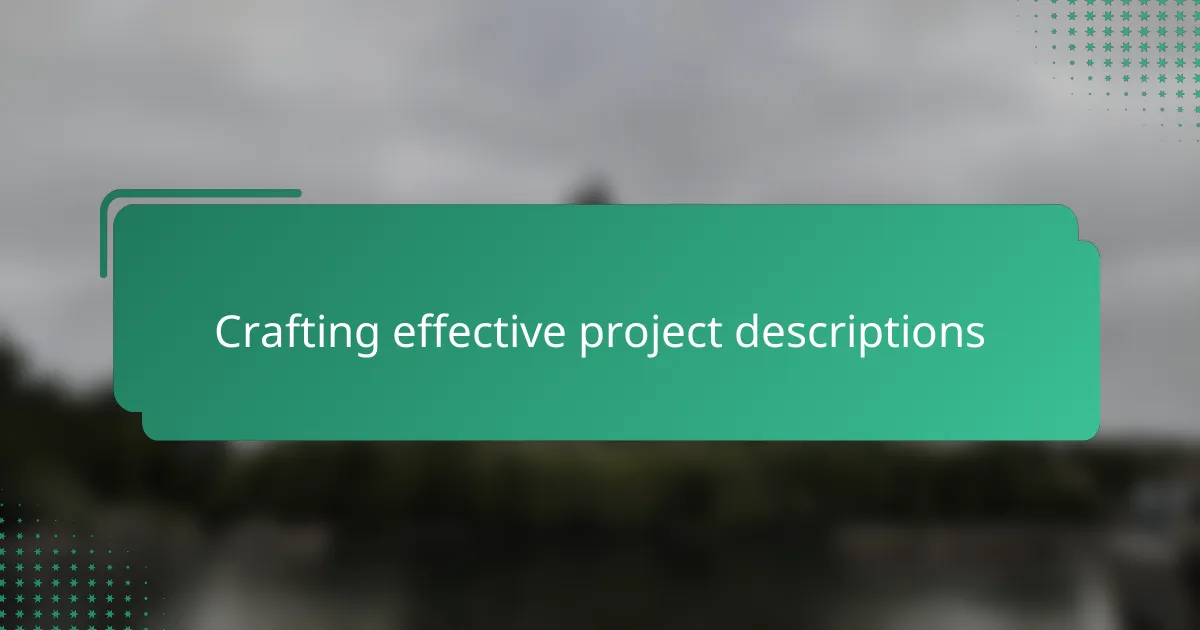
Crafting effective project descriptions
Writing project descriptions felt like telling the unseen story behind each prop. I found that clear, concise language made my models more approachable. Have you ever stumbled on a description so vague that it made you lose interest before even seeing the art? I definitely have, and it pushed me to be deliberate with every word.
I like to blend technical details with narrative hints—mentioning materials used, design inspiration, or the imagined function of the prop. These little insights invite viewers to imagine the world the model belongs to. For example, describing a worn grip or customized interface adds layers of personality I want others to feel.
Sometimes, I asked myself, “Will this explanation spark curiosity or just inform?” Striking that balance between being informative and engaging took practice. But when I got it right, I noticed more meaningful comments and connections with fellow artists who shared my passion for science fiction storytelling.
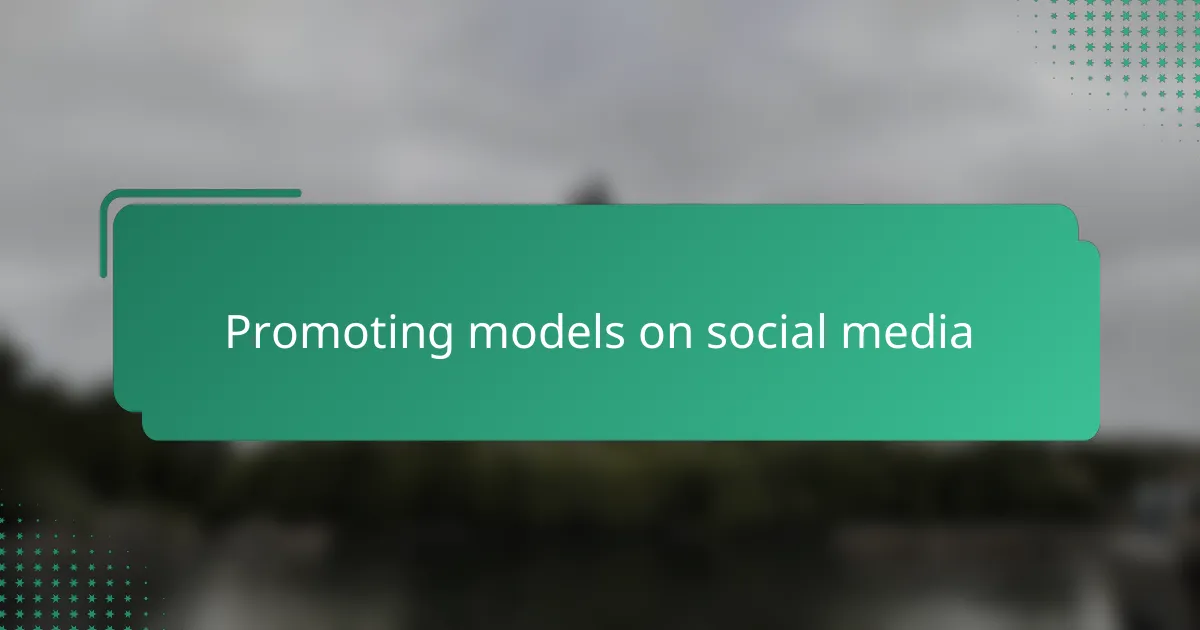
Promoting models on social media
Promoting my models on social media became a natural extension of sharing my passion. I found that posting regular updates—even just quick behind-the-scenes shots or work-in-progress snippets—kept my audience curious and engaged. Have you ever noticed how a simple process clip can spark as much interest as a finished render? That ongoing engagement builds a connection that lasts beyond the initial reveal.
I also learned the importance of tailoring posts to each platform’s vibe. For instance, Instagram’s visual focus meant I had to craft eye-catching thumbnails with concise captions, while Twitter gave me room to share quick thoughts or tag relevant sci-fi communities. It’s a bit like speaking different languages, but when done right, it amplifies the reach and invites new viewers to explore my ArtStation portfolio.
One personal insight was realizing that social media isn’t just about broadcasting—it’s about dialogue. When someone comments or shares a thought, it felt rewarding to respond and exchange ideas. Those interactions made me see my models not just as objects, but as conversation starters in a larger creative universe. Isn’t that what art is truly about?
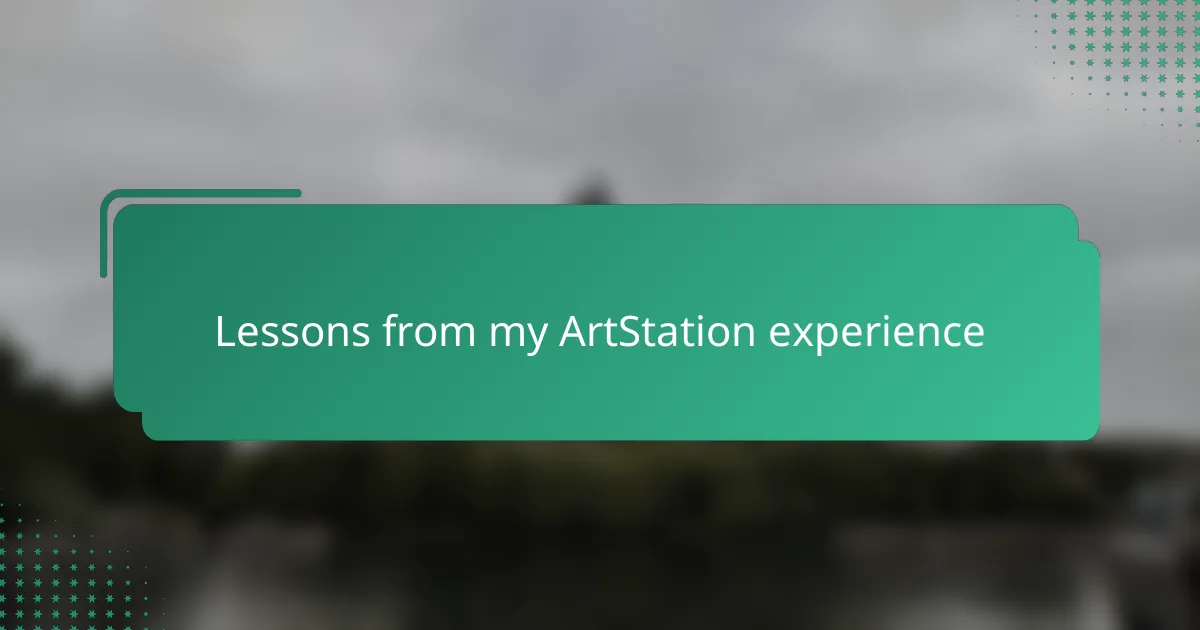
Lessons from my ArtStation experience
One lesson that really stood out during my ArtStation journey was the importance of consistency. I noticed that regularly updating my portfolio, even with smaller pieces, kept my work visible and fresh in the minds of viewers. Have you ever wondered why some artists seem to effortlessly maintain attention? For me, it boiled down to showing commitment through steady progress rather than sporadic bursts.
Another insight came from interacting with the ArtStation community. Early on, I hesitated to ask for feedback, fearing criticism. But I quickly learned that constructive comments actually pushed me to refine my models and storytelling. That exchange not only improved my work but also made me feel part of a broader creative family, which was deeply motivating.
Lastly, I discovered the value of patience in this space. Success on ArtStation didn’t happen overnight. Sometimes, posts would receive few views or likes, which was discouraging. Still, I reminded myself that each model added to my growth and portfolio narrative. Does that patience pay off? From my experience, absolutely—it’s the steady accumulation of effort that turns passion into recognition.
